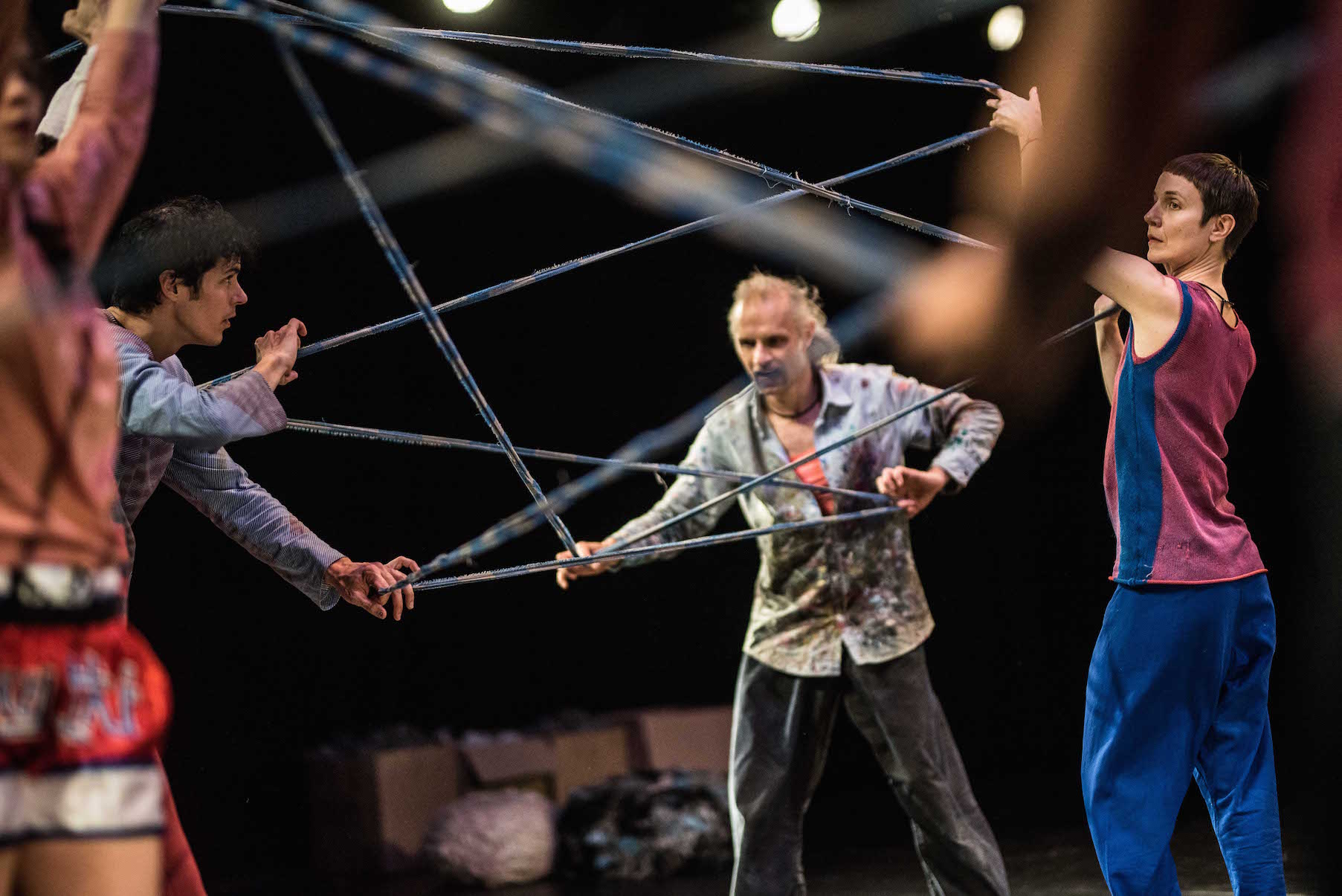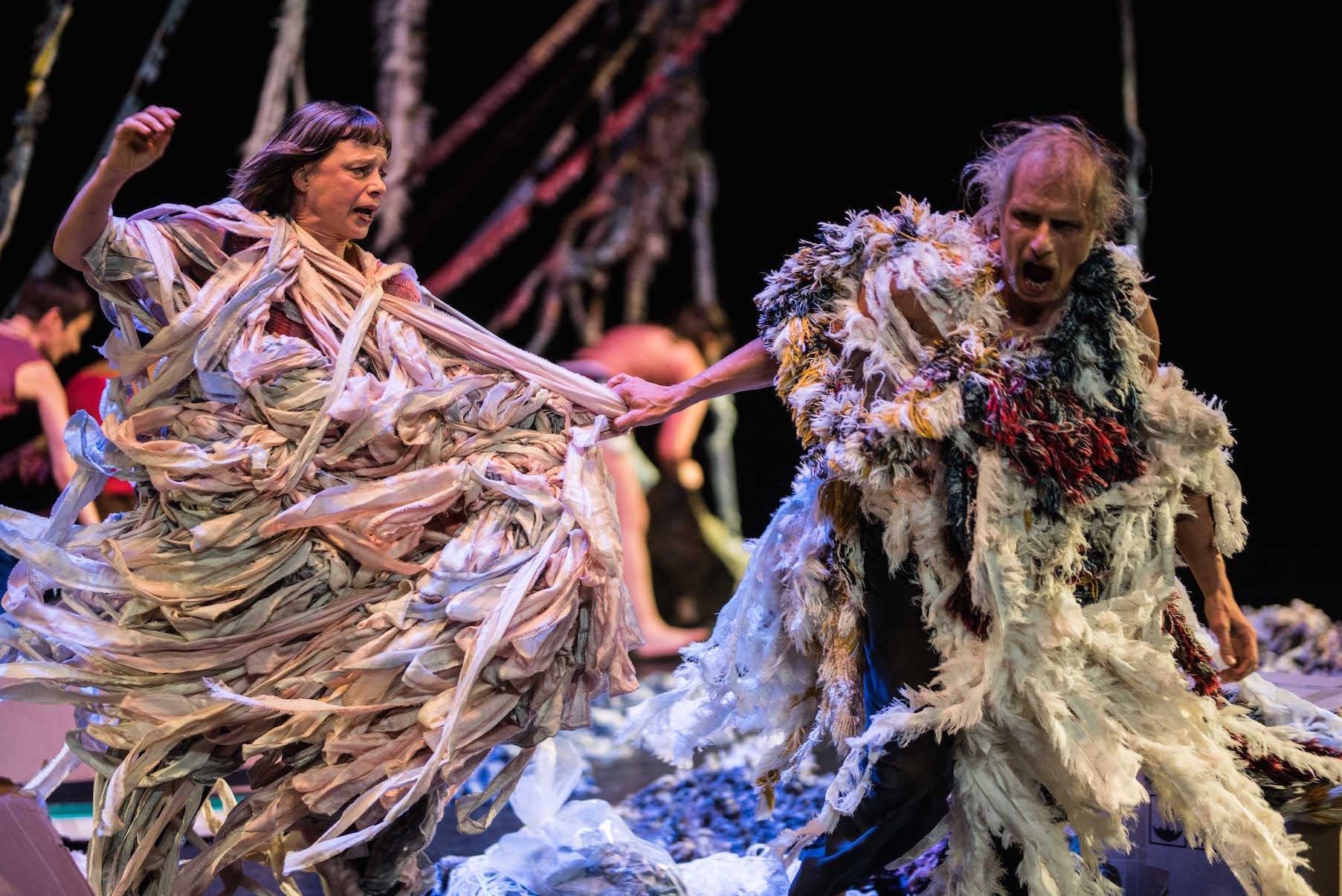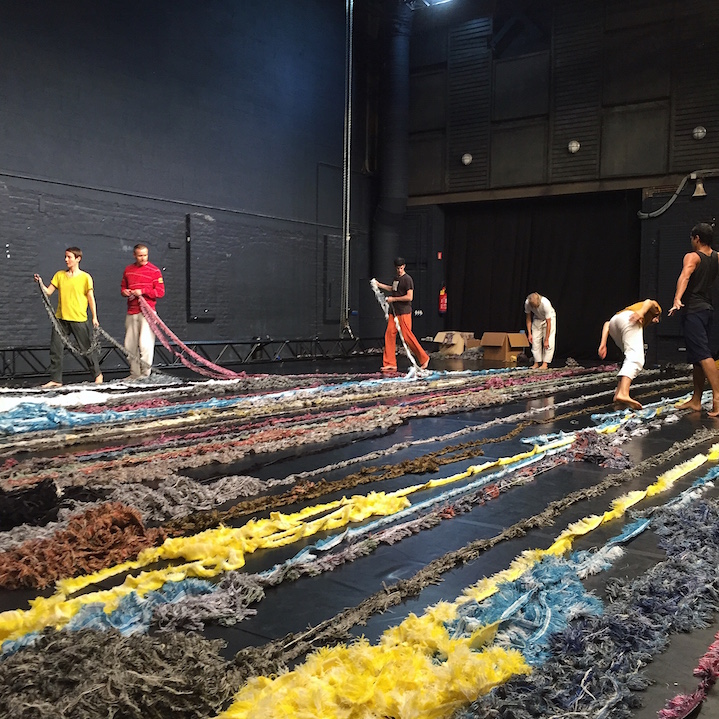
How to proceed
To mark the 20th anniversary of his company, Thomas Hauert pays tribute to his most faithful collaborators
In praise of complexity: creativity on show
For the 20th anniversary of ZOO, Thomas Hauert pays tribute to his most faithful collaborators. The artistic and virtuoso specifies of the dancers (Sarah Ludi, Samantha van Wissen, Mat Voorter, Gabriel Schenker, Fabian Barba, Liz Kinoshita and Albert Quesada) are honoured; as well as the lighting creations of Bert Van Dijck, the costumes and scenography of Anne Masson and Eric Chevalier, Mauro Lanza’s musical compositions and François Gremaud dramaturgical contribution. Thomas Hauert blurs here the edge between creative process and representation. He takes us in a powerful trompe l’oeil where the speech expresses an anger teeming with the excesses of the world. This unprecedented multifaceted dialogue brains the inventiveness of each person in an enthralling eulogy of complexity.
How to proceed assimilates the very process of creation on stage, as in a kind of trompe l’oeil. Rather like those musicals that tell the story of rehearsing for a musical, an ambiguity will arise between the process of creation itself and the representation of that process. The material used – musical, choreographic, dramatic and artistic – is eclectic to give the dancers a wide range of forms of expression as performers on stage, at the same time the whole piece is bound by the dramatic structure that is based on the blurring between rehearsal and show.
This structure becomes a kind of mechanism that implements – and makes tangible – the idea that there is not one simple logic, one form of awareness or one single vision in response to a complex set of possibilities and parameters. It is but human to want to find ‘the’ formula for making a political system function, taming the vagaries of love, or organising a city. But the promise of a perfect blueprint will forever remain an illusion, as human beings, society and nature do not function with ideal mechanisms. And yet humans continue to be nostalgic for a perfect world, a utopia of a harmonious society that gives meaning to our existence. How to proceed accepts the impossibility of this utopia and refuse to come to a perfect solution, ‘true’ beauty and a unified aesthetic. Hauert recognizes how seductive unitary (and artificial) solutions can be, but he wants to invite us to see the beauty that resides in complexity. Indecision is closer to life’s processes than are aesthetics that are devoid of disturbing elements – those that sully the purity of an unadulterated idea.
A “suite of dances”
To extend this quest musically, Thomas Hauert asked the contemporary Italian composer, Mauro Lanza, to create an original piece. Mauro Lanza is a composer whose writing, far from purism, manages to bridge the gap between several opposing directions like high and low art. At once erudite and sensual, his writing has vertiginous depth and is full of humour. Hauert and Lanza first worked together in 2015. For La mesure du désordre Hauert used existing pieces of Lanza’s work. In 2016, Hauert cut, pasted and sampled Lanza’s music, with his blessing, for inaudible. The logical outcome of their artistic affinities was the writing of an original musical piece. Thomas Hauert asked Lanza to create a form of “suite of dances”, a series of highly eclectic musical selections. Lasting 30 seconds to 4 minutes each, they are modeled dance suites: “After the experiments of inaudible and La mesure du désordre, which were already using some of my “pre-existing” music, I was enthusiastic to accept Thomas’ offer when he suggested I write original music for his company’s anniversary play. The result of this new collaboration is a series of short electronic dances of both dreamlike and mechanical character, the longest of which uses the dancers’ voices as the main source material. This material is analysed and tuned, and becomes the basis for a kind of virtual orchestra, where the identity of the vocal imprint can disappear or be magnified to the point of paroxysm. Mat Voorter, metamorphosed into a Grindcore singer, can be recognised in particular».
Words in the world
The oral text in the show (monologues, dialogues, choruses) rather than simply being spoken, are paced and chanted, as if set to music. Rather than taking quotations from existing texts, a synthesis, a stylisation of words spoken in the studio during the creation process, are used. These texts express a feeling of helplessness when confronted with the excesses of the modern world. However, much like Hakas, these texts will also give strength and present a form of revolt, teeming with anger. The spoken word is there as a witness, a marker of a creative process as well as naming the topics and questions of the play, including anger and happiness says François Gremaud (actor and director of 2B2 company) who accompany the dancers in the texts’ dramatic process.
Eight virtuoso dancers
In How to proceed, we find dancers who have accompanied Hauert for many years. Sarah Ludi, Samantha van Wissen and Mat Voorter have collaborated with Hauert since the founding of ZOO in 1997. While Gabriel Schenker, Fabian Barba, Liz Kinoshita and Albert Quesada have collaborated with ZOO since 2008. The piece is created for 8 dancers, including Hauert, of 2 different generations.
Costumes and staging, or the hesitant status of the visual image
For the costumes and staging, Hauert has called on Anne Masson and Eric Chevalier. As proven by their retrospective Des choses à faire at the CID (Centre d’Innovation et du Design, Grand-Hornu) they are creators who constantly question and unsettle the status of the textile medium, working between “doing”, “helping” and “being”.
Like all of Hauert’s work, this new creation promises to roll out a vastly expressive range. His feelings and concerns act as a warning system, which he displays on stage without any sugarcoating. Amongst the performers there is also a delicious diversity of build, ages, mother tongues and body language. The visual realm and the staging incorporate and support this multifaceted energy. The costume identity draw on this abundance to serve each dancer on the one hand, and support group dynamics on the other. The visual and chromatic vocabulary, the typology of clothing and the register of textures transmit some of the show’s moorings (ie Hakas, the charivari, songs). And this, not always in a settling way.
Together with the lighting designer, Bert Van Dijck, a dialogue between light and materials allow the stage to move between its status as rehearsal space, the space where the show is being made, and the show itself, the actual performance. To this end, the performers are imagined as actors of stagecraft, who elaborate, construct, transform, make and unmake the performance space, modifying the nature of the stage and questioning everyone’s place, the meaning of collective work and individual initiatives. The costumes and props are considered as versatile and mobile elements, capable of transforming space, of integrating with the dancers, resisting them or eliciting effort, of contributing to the rhythm and the sonorous realm of the piece.
From the outset, this scenographic and visual ambition involved experimental work on the stage with all the performers and skills involved, in which a transdisciplinary practice of textiles was brought into play. The process of creating How to proceed transposed the hesitations, frailties, radiance and inventions of each performer into the “material”, the very weave of the show.
Concept & direction Thomas Hauert
Created & performed by Fabian Barba, Thomas Hauert, Liz Kinoshita, Sarah Ludi, Albert Quesada/Federica Porello, Gabriel Schenker, Samantha van Wissen, Mat Voorter
Music Mauro Lanza (Commissioned by Ircam-Centre Pomidou), Mina/Beatles, J.S. Bach
Sound Bart Celis
Dramaturgic collaboration François Gremaud
Scenography Chevalier-Masson, Bert Van Dijck, ZOO
Costumes Chevalier-Masson
Costumes production Isabelle Airaud
Light Bert Van Dijck
Production ZOO/Thomas Hauert, DC&J Creation
Coproduction Théâtre de Liège (BE) / Charleroi danse – Centre Chorégraphique de la Fédération Wallonie-Bruxelles (BE) / Ircam – Institut de Recherche et Coordianation Acoustique/Musique (FR) / Les Spectacles vivants – Centre Pompidou (FR) / Les Susbistances – Laboratoire International de création artistique (FR)
With the support of Fédération Wallonie-Bruxelles – Service de la danse / Pro Helvetia – Fondation suisse pour les arts / Ein Kulturengagement des Lotterie-Fonds des Kantons Solothurn / Wallonie-Bruxelles International / GC De Kriekelaar and the tax-shelter of the belgian federal government
Studio Charleroi danse, La Raffinerie (BE) / Grand Studio (BE) / GC De Kriekelaar (BE)




